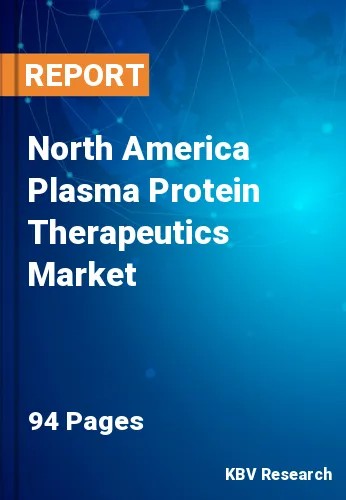The North America Plasma Protein Therapeutics Market would witness market growth of 4.5% CAGR during the forecast period (2023-2029).
Protein components fractionated from human plasma are used to prevent, manage, and treat life-threatening illnesses brought on by trauma, immunologic disorders, congenital deficits, or infections. Frequently, these treatments are the only ones available. However, much has changed in the last few years to enhance immunoglobulin G recovery, improve product purity, and isolate new plasma proteins like von Willebrand factor, α1-protease inhibitor, and protein C.
Fractionation refers to the industrial procedure utilized to separate therapeutic plasma proteins. In batches of several thousand liters, in around 70 plants, more than 23 to 28 million liters of human plasma are fractionated annually. Modern plasma fractionation integrates industrial processes to isolate, sequentially and cohesively, the crude portions further refined into specific medicinal products. A beginning plasma pool that may have had infectious pathogens in it is rendered inactive or removed by verified specific processes. This complicated industrial process is carried out in plasma fractionation factories that are licensed facilities that are operated in accordance with good manufacturing practices as well as according to quality assurance criteria.
According to the CDC's October 2021 update, an estimated 78.4 million persons age 18 and older would likely have arthritis that has been officially diagnosed by 2040. The goal of platelet-rich plasma therapy, also known as PRP therapy or autologous conditioned plasma (ACP) therapy, is to use the blood's inherent ability to mend to restore injured tendons, ligaments, muscles, cartilage, or even bone. Arthritis is now being treated using therapy. Therefore, it is projected that the rising number of arthritis patients in the United States would open up prospects for cutting-edge plasma protein therapies. In light of this, the regional market is anticipated to experience significant growth over the forecast period due to the rise in blood-related disorders, rising incidence and prevalence of autoimmune and neurological ailments, and research and development in plasma protein.
The US market dominated the North America Plasma Protein Therapeutics Market by Country in 2022, and would continue to be a dominant market till 2029; thereby, achieving a market value of $11,658.6 Million by 2029. The Canada market is poised to grow at a CAGR of 6.8% during (2023 - 2029). Additionally, The Mexico market would witness a CAGR of 5.9% during (2023 - 2029).
Based on End User, the market is segmented into Hospitals, and Others. Based on Product Type, the market is segmented into Immunoglobulin, Albumin, Plasma derived factor VIII, and Others. Based on Application, the market is segmented into Hemophilia, Idiopathic Thrombocytopenic Purpura, Primary Immunodeficiency Disorder, and Others. Based on countries, the market is segmented into U.S., Mexico, Canada, and Rest of North America.
Free Valuable Insights: The Worldwide Plasma Protein Therapeutics Market is Projected to reach USD 39.1 Billion by 2029, at a CAGR of 5.5%
The market research report covers the analysis of key stake holders of the market. Key companies profiled in the report include Bayer AG, Abeona Therapeutics, Inc., Takeda Pharmaceutical Company Limited, Grifols, S.A., Baxter International, Inc., Kedrion S.p.A, Octapharma AG, CSL Limited (CSL Behring), Taibang Biological Group Co., Ltd and ADMA Biologics, Inc.
By End User
By Product Type
By Application
By Country
Our team of dedicated experts can provide you with attractive expansion opportunities for your business.

